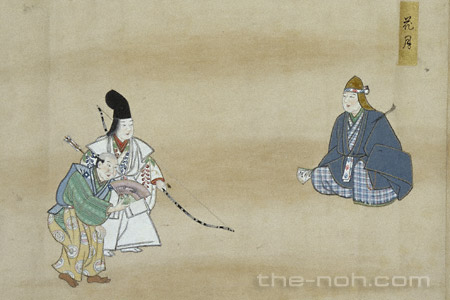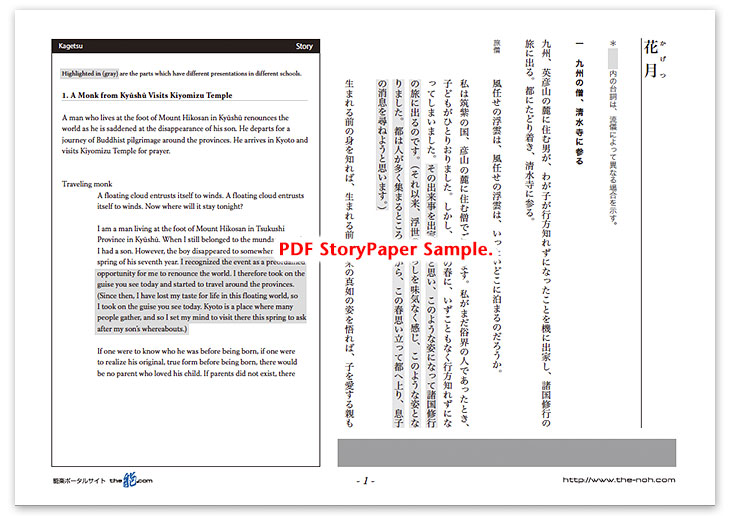
 Kagetsu
Kagetsu

![]()
In the province of Tsukushi in Kyūshū, there is a man who lives at the foot of Mount Hikosan. When his seven-year-old son went missing, he renounced the world and departed on a journey of Buddhist pilgrimage. After travelling around the provinces, the man, now a monk, arrives in Kyoto in spring and visits Kiyomizu Temple for prayer.
There, the monk meets a man from the town which had grown around Kiyomizu Temple and asks whether there isn’t anything entertaining in the temple. The local man tells him that a boy named Kagetsu performs an amusing kusemai (storytelling with dance), calls Kagetsu out, and recites a song together with the boy. After the song, Kagetsu is about to shoot an arrow at a bush warbler to punish it for staying in the cherry blossoms and making them fall, but remembering that this would violate Buddhist precepts against killing, he stops. Then, at the urging of the local man, Kagetsu performs the kusemai which describes the origin of Kiyomizu Temple.
The monk who has been keenly watching Kagetsu, determines that the boy is his missing son and identifies himself as his father. Celebrating the delightful moment of the reunion of father and son, Kagetsu beats a kakko drum (a small, waist-mounted bifacial drum) and dances. After performing a dance which describes his life since he was abducted by a tengu (long-nosed goblin) at the age of seven, the father-monk and the son set out together on a journey to follow the Buddhist Way.
![]()
Kagetsu, having been kidnapped by a tengu (long-nosed goblin) at the age of seven and having followed a strange destiny, is the main character. Although the theme of this drama is the reunion of a father and son who have been separated for many years, the highlights of this piece are indeed the series of dances that Kagetsu performs. After being kidnapped, he travelled around provinces, ended up arriving at Kyoto, and became a popular juvenile entertainer performing various dances and songs. He sings a popular song, “Love is Trouble,” performs a kusemai (storytelling with dance) which describes the origin of Kiyomizu Temple, dances to the sound of a kakko drum which he plays, and finally recites his experiences of travelling in the mountains in the provinces.
There’s none of the heavy atmosphere one might expect of the theme of separation of parent and child; rather, the chants and dances are airy and jazzy. The audience can fully enjoy the fascinating performance of Kagetsu, a cute boy star.
Also, you cannot overlook the strong presence of the ai-kyōgen, who performs the role of the “Man living in the town around Kiyomizu Temple.” He finds whatever reasons to tease Kagetsu and inspires the juvenile entertainer to perform one dance after another. The ai-kyōgen shows you the true value of the role, and guides the progress of the entire drama.
STORY PAPER : Kagetsu
Story Paper presents noh chant stories in modern speech, with story outlines, highlights and more using Adobe PDF format, which can print out and zoom in. Print out the pages and take them with you when you see the actual noh performance.

The copyright of Story Paper is held by the Noh.com. Story Paper is for individual use only. It is prohibited by the copyright law to distribute or publish printed-out Story Paper pages without prior consent. For more information, check the credit and disclaimer pages.



 [Kagetsu : Story Paper PDF : 493KB
[Kagetsu : Story Paper PDF : 493KB